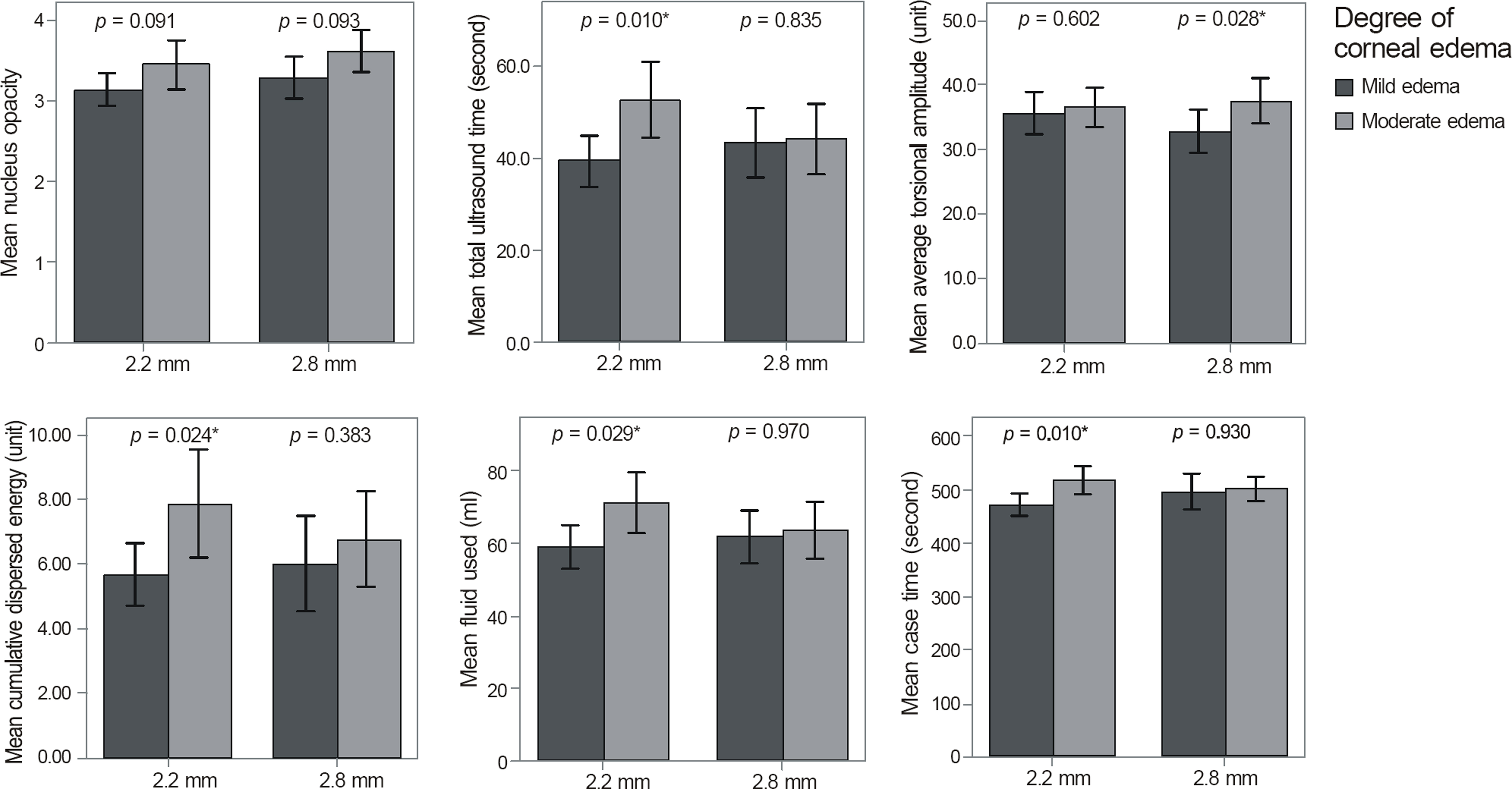J Korean Ophthalmol Soc.
2013 May;54(5):709-715. 10.3341/jkos.2013.54.5.709.
Comparison of Phacodynamic Effects on Postoperative Corneal Edema Between 2.8 mm and 2.2 mm Microcoaxial Torsional Phacoemulsification
- Affiliations
-
- 1Department of Ophthalmology, Jeju National University School of Medicine, Jeju, Korea. amario@naver.com
- KMID: 2217035
- DOI: http://doi.org/10.3341/jkos.2013.54.5.709
Abstract
- PURPOSE
To compare the effects of phacodynamic parameters on postoperative corneal edema between 2.8 mm and 2.2 mm microincisional coaxial cataract surgery.
METHODS
A prospective randomized study design was conducted and included 144 cases randomly divided into 2 coaxial cataract surgery groups based on incision size, a 2.8 mm incision (n = 72) or a 2.2 mm microincision (n = 72). The cataract was graded using the lens opacity classification system (LOCS III). The total ultrasound time (TUT), cumulative dispersed energy (CDE), average torsional amplitude (ATA), fluid amount, and case time were measured for each surgery. Central corneal thickness (CCT) was measured preoperatively, and 1 day and 1 month postoperatively. Intraoperative parameters were correlated with postoperative corneal edema.
RESULTS
The average nuclear opacity, intraoperative parameters, and postoperative corneal edema did not differ significantly between the 2 surgical groups. Regression analysis showed corneal edema to be significant in ATA (p = 0.028) in the standard (2.8-mm incision) coaxial group, whereas edema was significantly different with TUT (p = 0.001), CDE (p = 0.001), fluid amount (p = 0.021), and case time (p = 0.027) in the microcoaxial (2.2-mm microincision) group. CCT returned to baseline with an increase of 1.8% at 1 month.
CONCLUSIONS
In the microcoaxial group, sustained ultrasound exposure and prolonged case time caused moderate postoperative corneal edema, while ATA was a significant factor in the standard coaxial group. These data can be used to devise an effective surgical strategy for cataract treatment.
Figure
Reference
-
References
1. Kurz S, Krummenauer F, Gabriel P, et al. Biaxial microincision versus coaxial small-incision clear cornea cataract surgery. Ophthalmology. 2006; 113:1818–26.
Article2. Weikert MP. Update on bimanual microincisional cataract surgery. Curr Opin Ophthalmol. 2006; 17:62–7.
Article3. Kim HK, Lee HS, Park SH, Joo CK. Comparison between bima-nual microincisional cataract surgery and conventional coaxial phacoemulsification. J Korean Ophthalmol Soc. 2009; 50:537–41.
Article4. Berdahl JP, Jun B, DeStafeno JJ, Kim T. Comparison of a torsional handpiece through microincision versus standard clear corneal cat-aract wounds. J Cartaract Refract Surg. 2008; 34:2091–5.
Article5. Can I, Takmaz T, Yildiz Y, et al. Coaxial, microcoaxial, and biaxial microincision cataract surgery: prospective comparative study. J Cataract Refract Surg. 2010; 36:740–6.6. Oh TH, Lee SJ, Kim HS. Clinical outcomes of cataract surgery us-ing torsional mode phacoemulsification and soft shell technique. J Korean Ophthalmol Soc. 2009; 50:1313–8.
Article7. Zeng M, Liu X, Liu Y, et al. Torsional ultrasound modality for hard nucleus phacoemulsification cataract extraction. Br J Ophthalmol. 2008; 92:1092–6.
Article8. Liu Y, Zeng M, Liu X, et al. Torsional mode versus conventional ultrasound mode phacoemulsification: randomized comparative clinical study. J Cataract Refract Surg. 2007; 33:287–92.9. Lee KM, Kwon HG, Joo CK. Microcoaxial cataract surgery out-comes: comparison of 1.8 mm system and 2.2 mm system. J Cataract Refract Surg. 2009; 35:874–80.
Article10. Elkady B, Piñero D, Alió JL. Corneal incision quality: micro-incision cataract surgery versus microcoaxial phacoemulsification. J Cataract Refract Surg. 2009; 35:466–74.
Article11. Li YJ, Kim HJ, Joo CK. Early changes in corneal edema following torsional phacoemulsification using anterior segment optical coher-ence tomography and Scheimpflug photography. Jpn J Ophthalmol. 2011; 55:196–204.
Article
- Full Text Links
- Actions
-
Cited
- CITED
-
- Close
- Share
- Similar articles
-
- Comparative Study of Microcoaxial Cataract Surgery and Conventional Cataract Surgery
- Comparison of Clinical Outcomes Between Torsional Phacoemulsification of Infiniti(R) and Longitudinal Phacoemulification of Stellaris(R) Through 2.2 mm Microincision
- One-Year Outcome of Microcoaxial Cataract Surgery Using 1.8 mm and 2.2 mm Incisions Versus that of Conventional Cataract Surgery
- Surgically Induced Posterior Corneal Astigmatism in 2.2 mm Microcoaxial Cataract Surgery Versus 2.85 mm Coaxial Conventional Cataract Surgery
- Clinical Outcomes of Cataract Surgery Using Torsional Mode Phacoemulsification and Soft Shell Technique



